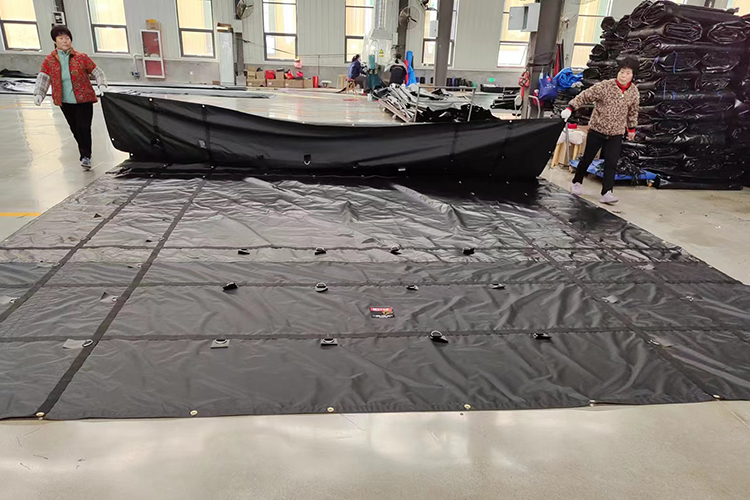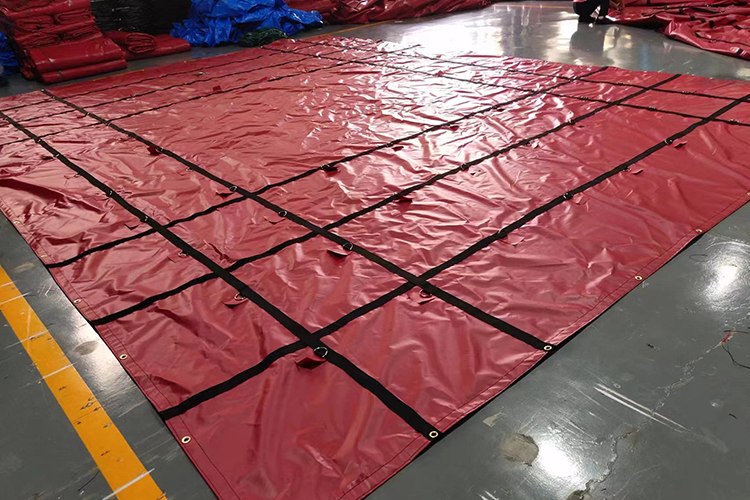PVC tarp is based on high-strength polyester canvas, coated with polyvinyl chloride (PVC) paste resin and compounded with accelerators (synthetic vegetable esters), antifungal agents, antiaging agents, antistatic agents, and other chemicals. Then, plasticized at high temperatures.
PVC tarp has waterproof, mildew-proof, cold-resistant, aging-resistant, anti-static, and other properties; and their breaking strength, tear elongation, and tear strength are much better than traditional tarps. It has a wide range of use, high strength, and various colors.
The surface of the PVC tarp is specially treated to prevent slipping. It is an internationally popular waterproof tarp.

What are the characteristics of PVC tarps?
Appearance: good color, bright and reflective; one side is flat and smooth, and there are some granular objects on the other side, indicating that the resin composition is appropriate and the temperature is appropriate; no pinholes, high resin density, good aging resistance, and long service life.
Stretch: According to different crafts, the material ratio of the canvas is kept improving, so that the damage to the cloth is small, and the stretchability will be better; the higher the warp and weft density of the yarn, the stronger the stretchability.
Waterproof performance: PVC tarp has 100% waterproof performance, good colloid, no pinholes in the canvas, and high-quality production materials. The addition of materials, resin composition, and density determine the performance of PVC tarpaulins.
Feeling: PVC tarp feels very soft. Although it feels average in thickness, the thickness has met the requirements. It is only because of the high resin content and good processing technology that it feels very soft and does not feel rough.
Environmental performance: Polyvinyl chloride tarp is based on the polyester filament, and the appearance is PVC double-sided coating. It is made of high-quality environmentally friendly resin, with a smooth surface and bright colors. High-temperature resistance, anti-ultraviolet, anti-aging, and other properties;

What are the usages of PVC tarps?
1. PVC tarps can be used as cargo tarpaulins for trucks, trains, and ships;
2. PVC tarps can be used as a cover for open-air warehouse yards in stations, docks, seaports, airports, etc.;
3. PVC tarps can be used for outdoor covering of temporary granaries and various crops and household groceries;
4. PVC tarps can be used as materials for building temporary sheds and temporary warehouses at construction sites, power construction sites, and other construction sites;
5. PVC tarps can be processed into camping tents and outer sheaths of various machinery and equipment;
6. PVC tarps can be used as a temporary shelter for leaky roofs;
7. PVC tarps can be used as a shelter for outdoor facilities and equipment in storms.
What should be paid attention to when using PVC tarpaulin?
Any kind of tarp needs good care and maintenance to last for a long period. If the following points can be achieved, a piece of tarpaulin can be used for a long time, fully reflecting its use value.
1. Tarp should be kept dry. After using the tarpaulin, hang the tarpaulin to air dry.
2. If stains are found on the tarpaulin, it should be gently scrubbed with water. Do not use chemically added detergents, and do not scrub hard, so as not to damage the waterproof membrane on the surface of the fabric and affect the waterproof function of the tarpaulin.
3. For the new Tarp, a layer of seam glue can be applied to the waterproof seam to enhance the waterproof effect.
4. When using the tarpaulin, please do not step on it directly with shoes on, so as not to damage the strength of the fabric.
5. When building the tarpaulin, the tarpaulin should be fixed on the ground, so as not to be pressed firmly with bricks, etc., resulting in collapse.
6. Avoid dragging the tarpaulin on the ground during use;
7. The tarpaulin should avoid hitting and tearing with sharp metal or sharp objects;
8. If the tarpaulin is damaged during use, you can clean the damaged part first, wipe it with alcohol, and then repair it with tarp tape on the cloth head and the damaged part.

